| |
PVC Rockets
The true purist would only launch fresh spuds but rockets constructed of seasoned polyvinyl chloride finish a close second. This legendary design produces rockets with outstanding flight characteristics. The size of the rocket depends on the barrel used. A rocket for a 1.5" barrel is commonly 3/4"x11". A rocket for a 2" barrel might be 1"x16", both using sch 40 PVC. Construction requires a technique called flaring which uses hot oil to melt the PVC.
If you are under 18 years old, ask a smart adult to help you with this project.
|
Prepare the pipe by cutting, deburring and washing to remove anything that would cause the oil to splatter. If the pipe is washed with water, dry it completely inside and out to avoid severe oil splatter. Heating the oil is the toughest part, Bring the oil up to temperature slowly. It takes longer to cool the oil down than to heat it up so take your time. In a small pan (not your wife's or Mom's), heat about .6" of cooking oil until it will soften PVC. If the oil smokes, it is way too hot. Place one end of the pipe in the oil and hold. After about 20 seconds the PVC will begin to soften allowing you to start the bell shape flare on the bottom of the pan. Spin the pipe to achieve an even shape.
|

|
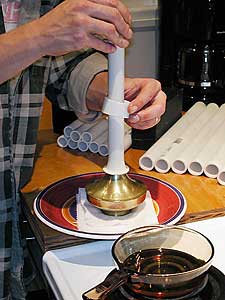
|
Use an upside down metal funnel or other round, tapered device as a stand to help push the flare further up the rocket. Cut a section of pipe the same as your barrel to use as a sizing ring. Lower the ring from the top down to the flared end. The flare should be larger than the ID of the sizing ring so that the ring forms it into a perfect circle. If it is too small, return the rocket to the oil, pushing the flare further out on the bottom of the pan.
|
|
Once the flare makes full contact with the ring, hold in place allowing the plastic to cool. A slight turning motion may help the ring from melting.
|

| |
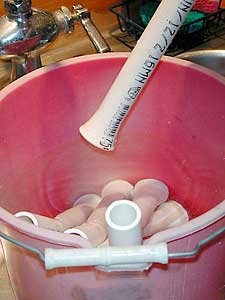
|
After the flare has cooled, place it in a bucket of cold water to help freeze it in place. Avoid getting any water on the sizing collar as it will be in contact with another rocket which may need to go back into the oil.
|
|
With a workflow established, production can be increased. Here one rocket is in the oil while another cools before it goes into the water.
|
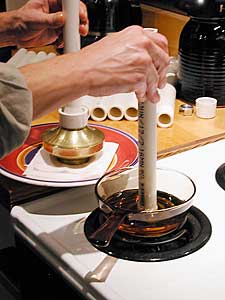
| |

|
The finished flares, each looking a little different. Practice will lead to a consistent shape. All of these rockets fly equally well but some survive passing completely through a target better than others. Can you guess which ones?
|
|
Weight can be added to the nose cap to change flight characteristics or to add destructive force. A couple washers held in place with the PVC pipe itself usually fits the bill. Pictured here are lead key weights from Steinway pianos, flattened into a disk. These are held in place on a bed of hot glue, providing added strength to the cap. The balance of this rocket comprises of the weight in the nose vs the drag produced by the flare. To test this, tie a long string to the middle of the rocket and spin it in a circle about 10" out. It should tumble then stabilize once it reaches higher speeds.
|
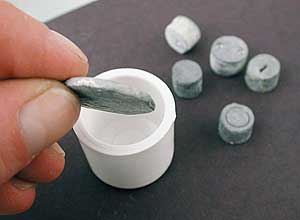
|

|
Prime and cement the end cap to the tip of the rocket. This is a good chance to use up some of that purple primer that's been kickin' around. Check the expiration date on the bottom of the can.
|
|
Hold the union together to prevent the pipe from backing out of the tapered fitting. The ring of cement is a good sign as it shows the joint is completely saturated. The plastics industry is undecided whether or not to wipe up this ring of cement. One group suggests the ring prevents the solvent from evaporating completely resulting in soft welds. They also advise that the solvent ring can soften the plastic underneath changing the weave of the polymers in the area. The other group proposes the solvent ring is a good thing by providing extra sealant and strength in high pressure applications. Both methods work well, what is more important is using the proper primer and cement.
|

|
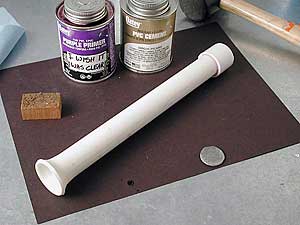
|
The finished rocket, fragile but powerful. When shot from a combustion launcher, these rockets can penetrate completely through 3/4" plywood. The rocket usually does not survive as the tail breaks when passing through the smaller hole. Visit the launch examples page for pictures of PVC rockets in action.
|
|
|
|









